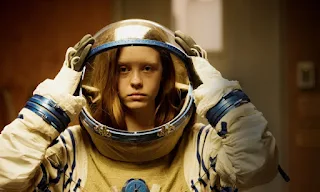‘Interstellar’ did a good job of approaching it, but Claire Denis one-upped Christopher Nolan with her space travel.
 |
| The Movie That Best Predicted Sagittarius A*, The Black Hole At The Center Of Our Galaxy |
The news given today by the international team of the Event Horizon Telescope (EHT) in Munich, with the first image of the “Sagittarius A” black hole , located in the center of the Milky Way, is one that fills with emotion and awe.
However, when this same team of scientists presented the first image taken of a black hole three years ago (in the distant galaxy Messier 87), we were already able to verify that speculative cinema had somewhat scraped the scoop on reality.
Viewers of Interstellar (2014) rushed to point out the similarities between that first real image of a black hole and what was shown in Christopher Nolan’s film, which since its premiere has become one of the most cited references in science fiction given its fidelity to known science within the liberties that can be taken in creating a work of fiction.
Not for nothing did Interstellar feature astrophysicist Kip Thorne as its chief scientific consultant, taking inspiration directly from his work. However, then came another more recent film that came even closer to the representation of a black hole: High Life (2018), directed by Claire Denis.
The French filmmaker won the FIPRESCI critics’ award at the San Sebastian Festival with this space, intimate and sexual epic starring Robert Pattinson, Juliette Binoche, Mia Goth and rapper André 3000, among others. In it, a group of juvenile delinquents trade their prison sentences for embarking on a space voyage of uncertain destiny to the closest black hole to Earth.
Black holes like two drops of water
The ship in which they travel through the cosmos, designed by the Danish Olafur Eliasson, is like a large floating laboratory prison, where they carry out a variety of experiments on reproduction. After various vicissitudes and visits to an orgasm machine, at the climax of the film a huge black hole very similar to M87 makes an appearance, although it was created for the film a year before the latter was portrayed.
 |
| The Movie That Best Predicted Sagittarius A*, The Black Hole At The Center Of Our Galaxy |
Denis herself commented on the news in an interview, and how after the publication of the image she did not stop receiving messages and calls telling her how similar both black holes were. A comparison with what we have been able to see of our ‘close’ Sagittarius A* also makes the similarity clear.
There is a clear precedent for the black hole in High Life in Denis’s own work: the abstract short film Contact (2014), a previous collaboration between the director and Eliasson for an installation by the Dane at the Fondation Louis Vuitton in Paris. A line of light that grows over a dark void, not unlike what turned out to be the representation of the black hole that the BUF special effects company carried out in the film.
How is a black hole created?
In the same way that Nolan had Thorne as a guide and reference, in High Life the position of scientific consultant (or, better yet, “cosmic partner”, as identified by the credit titles), was the French astrophysicist Aurélien Barrau, an expert in the field of black holes who has also stood out in the field of philosophy as a disciple of Jean-Luc Nancy; thinker who has always occupied an important place in Denis’ work.
 |
| The Movie That Best Predicted Sagittarius A*, The Black Hole At The Center Of Our Galaxy |
With scientific restraint, Barrau removes a certain magnitude of astonishment from the coincidence between the appearance of fictional black holes and the real ones that we can now see in images. In an interview for Inverse, he explained that it should not be a surprise because that is why he himself had taken pains to create a realistic black hole without exceeding artistic license in the representation.
“Even if we didn’t have any photos, five or even more than ten years ago we were already fully capable of calculating what a black hole might look like,” says Barrau. “When you make a movie, you have a map of the stars, and with the general relativity equation, it’s not hard to figure out how a black hole would distort it.”
It was also difficult to imagine what would happen to someone who entered a black hole, as in High Life. The character of Mia Goth suffers this horror from inside a capsule that ends up penetrating the black hole: her body stretches and decomposes until it bursts into pieces.
This effect of extreme changes in a non-homogeneous gravitational field is what is known in astrophysics with a term as visual as ‘spaghettification’, which in the film also tried to be reproduced in the most reliable (and creepy) way possible. Only, in this case, we hope not to have the opportunity to verify how successful or not the representation was.
